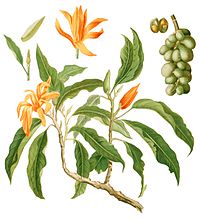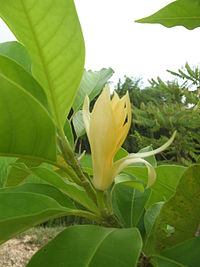 Magnolia champaca
Magnolia champaca
From Wikipedia, the free encyclopedia
This article is about the flower. For the magazine of the same name, see
Champak (magazine).

|
|---|
|
| Scientific classification |
| Kingdom: |
Plantae |
| (unranked): |
Angiosperms |
| (unranked): |
Magnoliids |
| Order: |
Magnoliales |
| Family: |
Magnoliaceae |
| Genus: |
Magnolia |
| Species: |
M. champaca |
| Binomial name |
Magnolia champaca
(L.) Baill. ex Pierre |
| Synonyms |
- Champaca michelia Noronha
- Magnolia membranacea P.Parm.
- Michelia aurantiaca Wall.
- Michelia blumei Steud.
- Michelia champaca L.
- Michelia euonymoides Burm.f.
- Michelia pilifera Bakh.f.
- Michelia pubinervia Blume
- Michelia rheedei Wight
- Michelia rufinervis Blume
- Michelia rufinervis DC.
- Michelia sericea Pers.
- Michelia suaveolens Pers.
- Michelia tsiampacca Blume
- Michelia velutina Blume nom. illeg.
- Sampacca euonymoides (Burm.f.) Kuntze
- Sampacca suaveolens (Pers.) Kuntze
- Sampacca velutina Kuntze
- Talauma villosa f. celebica Miq.
|
Magnolia champaca, commonly called
yellow jade orchid tree, is a large evergreen tree, native to the
Indomalaya ecozone (consisting of
South Asia,
Southeast Asia and some parts of
China).
It is best known for its strongly fragrant yellow or white flowers. It
is, however, primarily cultivated for its timber, and is also used in
urban
landscaping. Its
aril-covered seeds are highly attractive to birds.
Varieties
This species occurs in varying shades of cream to yellow-orange. In China,
M. champaca var.
pubinervia is documented.
Magnolia × alba is a hybrid cultivar of
M. champaca. In Thailand, there has been some purported man-made hybrids with other magnolia species including
Magnolia liliifera and
Magnolia coco.
Etymology
The species epithet,
champaca, comes from the Sanskrit word
campaka (pronounced
tʃaɱpaka).
Vernacular names
Common names in other languages include
champaca,
champak;
Sonchaaphaa (सोन चाफ़ा) in the
Marathi language; Chenbakam/Chenpakam (செண்பகம்) in
Tamil; Chenbagam in
Malayalam; shornochampa (golden champa),
স্বর্ণচাঁপা in
Bengali; champa, cempaka, sampenga and sampangi in
Telugu; Sampige (ಸಂಪಿಗೆ) in
Kannada;
cempaka in
Malay;
jeumpa in
Acehnese and shamba. All other names above apply to
Plumeria varieties as well, with the exception of
Sonchaaphaa, which is used exclusively for this particular subvariety in Western India. Some half a dozen varieties of
Plumeria together with
Magnolia champaca (three varieties) and two varieties of
Ylang Ylang are generically called
Chaaphaa
in Marathi,Manoranjitam in Tamil, though in some cases, a further
descriptor is added: the red plumeria variety, for instance, is
Dev Chaaphaa or
God's Champa, and the two Ylang Ylang varieties each have a separate name as well.
Uses
Perfume
The flowers are used in Southeast Asia for several purposes.
Especially in India, they are primarily used for worship at temples
whether at home or out, and more generally worn in hair by girls and
women as a means of beauty ornament as well as a natural perfume.
Flowers are used to be floated in bowls of water to scent the room, as a
fragrant decoration for bridal beds, and for garlands.
"
Magnolia champaca however is more rare and has a strong
perfume, and is not that commonly or plentifully used - for example in
hair it is worn singly or as a small corsage but rarely as a whole
garland, and for bridal beds it is most often jasmine and roses while
for bowls of water to be placed around rooms usually other, more
colourful for visual decoration and less strongly perfumed flowers are
used."
The flower is sometimes commonly called the 'Joy perfume tree.' Many
niche perfumers are now once again using Champaca Absolute as single
note fragrances.
Cultivation
Magnolia champaca is cultivated and used as an ornamental tree in temperate climate gardens, such as in coastal California.
Related Posts : cempaka,
champaca,
magnolia
 Magnolia champaca
Magnolia champaca
Tidak ada komentar:
Posting Komentar